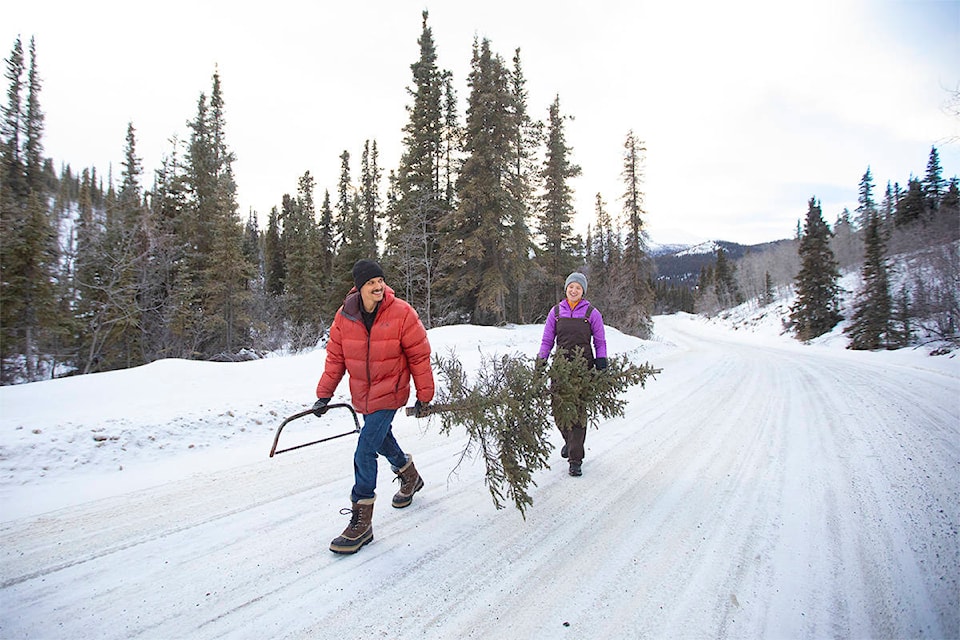While getting a live Christmas tree seems simple enough — take an axe to your conifer of choice, get it into your vehicle as intact as possible, prop it up in your house — there are a few other things you should also keep in mind on your harvest.
Unlike the unfortunate souls down south, Yukoners don’t need to rely on tree farms to get a solid Christmas tree, or even pay for one. Each household in the territory is entitled to take up to two trees every holiday season, no permits, licences or other nonsense required.
Before taking your wooden muse home though, you should first make sure its growing somewhere you’re actually allowed to harvest a Christmas tree, advises Rowan Brown, an assistant forest technician with the Yukon government’s Department of Energy, Mines and Resources.
“You don’t want to be on other people’s private land or First Nations settlement lands if you don’t have permission to be there,” she said on a recent field trip out to the Fish Lake area.
An interactive map on tree cutting areas in Whitehorse as well as more tips on how to go about harvesting and maintaining a tree are available on the Yukon government’s website at yukon.ca/en/science-and-natural-resources/forests/cut-down-christmas-tree-your-home
Once you’re sure you’re somewhere where you can harvest, it’s still a good idea to be aware of your surroundings — for example, if the tree of your dreams is by a road, try to cut it so that it doesn’t come crashing down across said road.
Try to leave as small of a stump as possible, too, so people coming after you don’t accidently trip or impale themselves on the remains of your tree.
And before you even go out, take a look at the space you’re planning on putting your festive shrub.
“You want to know the space that you’re going to put your tree in so you can look for one that’s an appropriate height,” Brown said.
“We really recommend you find one that’s suited for your space rather than cutting a really tall tree and cutting the top off of it … and that’s really just to minimize the residual materials that people are leaving behind when they cut a tree.”
There’s no rule about how big a small of a tree one can harvest, although, again, it’s recommend you take an appropriately-sized one instead of chopping a bigger one up. Brown and her colleague, forest management technician Dexter Kotylak, also recommend you leave trees with signs of wildlife activity — for example, squirrels’ nests or woodpeckers’ holes — alone.
When it comes to equipment and supplies, an axe or a bow saw should be more than enough to get the job done; a chainsaw is overkill for the size of tree you’ll likely be taking and not worth the effort of lugging out. A toboggan, although not necessary, can be helpful in getting your tree from the bush to your vehicle, as can be a tarp for bundling up your tree for transport (if you’re only going a short distance though, you won’t have to worry too much about needles falling off).
As with any winter activity in the Yukon, it’s also a good idea to bundle up and, if you’re planning on going somewhere remote, let someone know where you’re going and how long you expect to me gone.
In case you’re concerned about your harvest having a negative impact on the local ecosystem, Brown and Kotylak said it’s probably not worth losing sleep over — in fact, you may actually be doing the forest some good.
“Thinning the forest can be advantageous for the young seedlings … It frees up more space and more light and more nutrient resources for the remaining trees, so you can see a boost in growth for trees that don’t make it into a home for the holidays,” Brown said.
Kotylak agreed.
“Disturbances are kind of meant to interact with the forest and taking Christmas trees or small Christmas trees and thinning the forest isn’t different from any other type of disturbance,” he explained.
Both Brown and Kotylak also agreed that a real tree has a number of advantages over a plastic one.
“Real trees smell great, are a local product so they don’t have to get shipped up here from somewhere else, they’re organic,” Brown said.
“Harvesting a real Christmas tree, it gets you outside, it’s something really fun to do with family leading up to the holidays, there’s so many pros.”
Make sure to keep your tree well-watered once you get it home, both to keep it looking nice and to reduce the fire hazard (the stump should always be submersed in water; if your tree is too skinny to fit properly in its stand, you can wrap an old towel around the base, or wedge in some scrap wood). Using LED lights instead of incandescent lights, and turning the lights off for parts of the day, can also help reduce the chance of your beautiful, compostable decoration going up in flames.
One final parting tip?
Carrying a thermos of hot chocolate or warm apple cider never hurts.
Contact Jackie Hong at
jackie.hong@yukon-news.com
